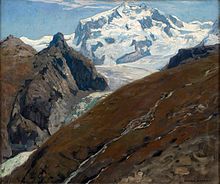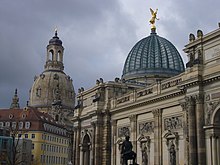Saxon Art Association


The Sächsischer Kunstverein was an association founded in Dresden in 1828 to promote contemporary art, especially in the Saxon region. The association dealt with lectures and discussions, the purchase of suitable works and the organization of art exhibitions and existed until 1945.
history
The Saxon Art Association was founded on April 7, 1828 in Dresden. The occasion was a gathering of art lovers on the 300th anniversary of Albrecht Dürer's death . The founding members included the then general director of the art academy Heinrich Vitzthum von Eckstädt , the head of the Dresden sculpture collection Karl August Böttiger , various artists and professors of the Dresden art academy as well as the art patron and writer Johann Gottlob von Quandt . At the general assembly on April 28, 1828, the members of the association elected him to be the first board of the association. On May 9, the statutes of the association were confirmed by the members of the governing committee.
The first 70 club members came from different social classes and were u. a. Nobles and court officials, commoners, artists and writers. Johann Wolfgang von Goethe could be won as an honorary member . One of the sponsors of the Saxon Art Association was the Saxon King Anton , who approved a grant of 500 thalers. The simple membership fee was at least one share (= 1 ticket), which corresponded to a value of five thalers.
The aim of the association was on the one hand to act as an educational mediator between citizens and artists and at the same time to promote contemporary artists through exhibitions and acquisitions. He also campaigned for the acquisition of paintings, sculptures, architectural plans and other art objects for the Saxon art collections. This was intended to compensate for the dwindling role of the nobility as a client for the visual arts and to replace it with civic engagement. Initially, the Saxon Art Association focused primarily on the promotion of “patriotic”, ie Saxon art, but soon expanded its sphere of activity to include artists from other German countries. The selection of the individual works was the responsibility of the committee of the art association, to which four artists and four art friends belonged.
In 1833 the doctor and painter Carl Gustav Carus took over the chairmanship of the association. In 1835, Carus implemented a change in the statutes of the association, according to which it was no longer exclusively Saxon, but “German artists from all over the world” that should receive attention from the Saxon Art Association. The number of members grew in the following years to approx. 1900, whereby these came not only from Saxony, but also from other countries. After the founding of the Empire in 1871, artists from other European countries also became the interest of the Saxon Art Association. In addition to regular exhibitions, lectures, discussions and debates on the entire spectrum of the visual arts were organized. In addition, the art association acquired works of art in order to raffle them among its members or to make them available to Saxon collections.
The artists considered with purchases and exhibitions by the Saxon Art Association included u. a. Caspar David Friedrich , Ludwig Richter , Louis Ferdinand von Rayski , Johan Christian Clausen Dahl and Edmund Kesting . The sculptor Ernst Rietschel , the composers Richard Wagner and Robert Schumann , the architect Gottfried Semper and the writer Karl Gutzkow also acted as members and sponsors , who made the association an intellectual center of the bourgeois-democratic circles of the city of Dresden.
The regular meetings took place first in Quandt's private apartment, later in the "Albina", a hall of the art academy on Brühl's terrace . From 1834 to 1848 they met in a house on Wallstrasse. In the 1840s, one of the exhibition venues was the former Calberlasche Zuckersiederei on Theaterplatz. Between 1887 and 1894, a new building for the academy was built according to plans by Constantin Lipsius . The Saxon Art Association moved into its own exhibition building in a side wing. All of the association's major exhibitions took place here until 1945. The building, which was destroyed in the air raid, was restored after 1990 and has served as an exhibition building again since 2005.
In 1946 the Saxon Art Association had to stop its work due to the political situation and was dissolved. The estate, which consists of numerous business files, correspondence (including between Quandt and Goethe), catalogs and art-historical documents, is located in the main state archive in Dresden . The New Saxon Art Association was established on April 29, 1990 as its successor .
Exhibitions of the Saxon Art Association (selection)
- Anton Graff - special exhibition (1913)
- The New Objectivity : Excerpts from German painting since Expressionism , traveling exhibition at the Städtische Kunsthalle zu Mannheim (October 18 to November 22, 1925)
- Exhibition of New American Architecture (October 17 - November 14, 1926)
- Large watercolor exhibition (1926)
- Lovis Corinth - Memorial Exhibition (1927)
- Anniversary exhibition "Saxon Art of Our Time" (July 21 - October 3, 1928)
- Max Feldbauer - special exhibition (January - March 1930)
- Arthur Lange - Memorial Exhibition (February 1931)
- Goethe exhibition (June - July 1932)
- Otto Hettner - Memorial Exhibition (September 1932)
- Carl Bantzer - Special Exhibition (March 28 - May 6, 1934)
See also
literature
- Erich Haenel (Ed.): Hundred Years of Saxon Art Association. 1828-1928. Limpert publishing house, Dresden 1928
- Cornelia Briel: The Saxon Art Association in the years 1828-1833. in: Dresdner Hefte No. 13, Dresden 1987
- Bärbel Kovalevski: The picture chronicle of the Saxon Art Association Dresden 1828-1836. Publishing house HW Fichter Kunsthandel, Frankfurt / Main 2010, ISBN 978-3981402308
Individual evidence
- ↑ Dirk Hempel: Literary Associations in Dresden: Cultural Practice and Political Orientation of the Bourgeoisie in the 19th Century , Max Niemeyer Verlag, Tübingen 2008, ISBN 978-3-484-35116-5 , page 66 ff.
- ↑ Holdings of the Saxon Art Association on the website of the Main State Archives Dresden ( page no longer available , search in web archives ) Info: The link was automatically marked as defective. Please check the link according to the instructions and then remove this notice.
Web links
- History of the Saxon Art Association 1828–1945 on the website of the New Saxon Art Association
- History of the Saxon Art Association
